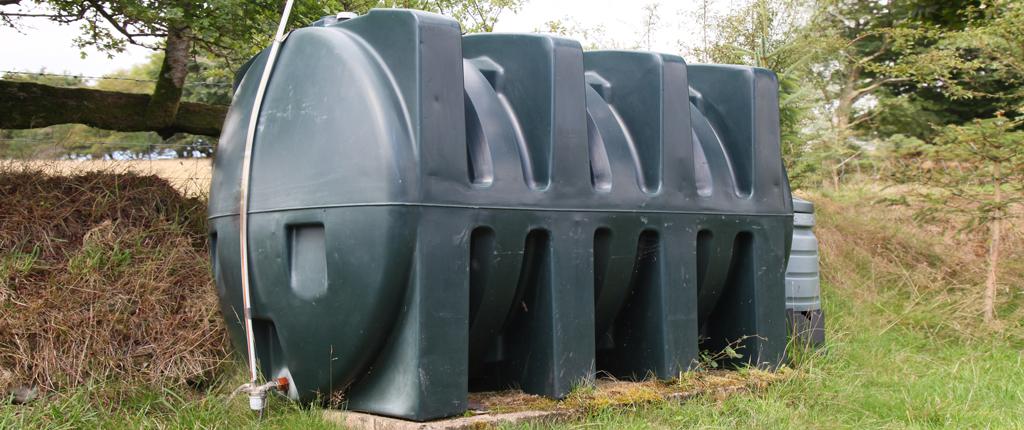Oil Tank Replacement: How to Get it Right
- How often should you change your oil tank?
- Fitting the right oil tank
- Where's the best place to fit an oil tank?
- Oil tank sizing
- Essential information for oil tank owners
- How much does a new oil tank cost?
- Do oil tanks need planning permission?
- Does homeowner insurance cover an oil tank?
- Alternatives to heating oil
- Your oil tank installation checklist

As the owner of an oil boiler, it's your responsibility to arrange an oil tank replacement.
A new oil tank is far less likely to leak and gives you the opportunity to increase capacity (if needed). Before going ahead with the replacement, you’ll need to make sure the installation meets a number of regulations.
So, consider this your oil tank installation checklist.
How often should you change your oil tank?
Oil tank replacement isn't something you'll need to worry about for at least 10 years. That's if it's been well maintained.
An oil tank that's been looked after may not need replacing for as long as 15 to 20 years.
Signs it's time for an oil tank replacement
Your oil boiler should be serviced once a year. And as part of this service, the heating engineer will look over the tank too. They'll be able to give you a clear idea of when you may need to think about an oil tank replacement.
As well as an annual service, it's a good idea to keep an eye on your oil tank over the years. If you spot any of the below then it could be time for a new oil tank:
- Oil leaks
- Condensation (especially during the summer)
- Damage and signs of corrosion (metal)
- Plastic swelling
If you're planning to buy a house with an oil tank then get it looked over by a professional.
Fitting the right oil tank
When looking for oil tanks, you'll come across the term 'bunded' quite a lot. A bunded oil tank means there's a tank around the storage tank. This extra tank acts as protection for the tank holding the oil.
If an oil tank is installed without bunding (single skin) then it must meet all sorts of regulations. And for those in Wales, all oil tanks must have bunding.

Integrally bunded
It's highly likely that your new oil tank will be integrally bunded. The oil storage tank will be within another tank for added protection. They're widely considered to be the best oil tanks around.
Double bunded (double skinned)
These have two layers to protect against leaks. The most common type of oil tank for underground installations.
Single skin
For a single skin oil tank to be installed it must have a capacity less than 2,500 litres and also meet many regulations. Those regulations include being further than 10m from water, away from drains and not fitted above hard ground.
Where's the best place to fit an oil tank?
You have three options when finding a location for your replacement oil tank. Either, outside,
inside or underground.
Above-ground outdoor
Most oil tanks are installed above-ground outside in the garden. For this to be possible, the oil tank installation must meet the following rules:
- 760mm from a non-fire-rated boundary
- 1.8 metres from doors, windows, garden sheds and your oil boiler's flue pipe
- 10 meters from a water source (rivers, streams, ponds and drains)
- 50 metres from a borehole, well or spring
In addition to the above, the tank can't be fitted in an area at risk of flooding or too close to drains or manholes in case of a leak.
The tank will need to be installed on top of a base of paving slabs or concrete. And this base must be up to scratch too:
- The base must be a fireproof material
- It must cover an area at least 300mm around the outside of the tank
- Paving slabs need to be 50mm thick (minimum) and 100mm for concrete
Above-ground indoor
An oil tank can be installed inside, normally in a garage or outhouse. But the room must be dedicated to the oil tank and contain nothing else.
For internal installation to be possible, the tank must have a capacity less than 3,500 metres and be accessible from all sides. There must also be at least 1.8 metres between the tank and any doors or windows. And even though it's inside, the environment still needs to be considered in case there's a leak.
Underground
By installing the tank underground, you will be keeping it out of view and hold onto more space in your garden. However, the task of installing a tank underground is challenging. This can lead to higher costs and take a fair amount of time.
A leak from an underground oil tank can lead to significant environmental concerns. So it must be double-bunded.
Oil tank sizing
Oil tanks are available in a range of sizes. From around 500 litres right up to 10,000 litres.
The best oil tank size for your home will depend on how much you’ll be using and how much room there is for the tank. As a rule of thumb, you’re looking at around 500 litres per room. However, if you have plenty of room for an oil tank, then you may want to go a bit bigger. This could save you money on oil as it won’t need filling up as often.
Essential information for oil tank owners
As the owner of an oil storage tank, you have a few environmental responsibilities and regulations to follow.
Environmental responsibilities
As an oil tank owner, it's your responsibility to make sure the oil doesn't leak out into the surrounding environment. Any leaks could damage the area and prove harmful to wildlife.
In the event of a leak, you will have to pay to clean the oil spill and any damages.
Regulations
During an oil boiler service or replacement, the heating engineer will inspect the oil tank. If they notice any issues, they must make you aware of them. They will recommend a course of action but cannot force you to go ahead with them. However, if you don't follow their advice for an oil tank replacement then they may refuse to replace your boiler.
How much does a new oil tank cost?
A new oil tank will cost between £1,100 and £2,000. Installation costs can stretch to around £1,000 on top of the tank itself.
Additional oil tank replacement costs
If there's any oil left in your old tank then this will need to be drained. This is normally done by your supplier and can cost £300 to £350. A new trench for the oil pipe may also be needed which can add another £500.
In the worst case scenario, you could be looking at oil tank replacement costs of almost £4,000. The cheapest oil tank replacement sits at around £1,000.
To get the best price for your oil tank replacement, we recommend comparing quotes.
Do oil tanks need planning permission?
If you live in a listed property then you will need planning permission for an oil tank. Otherwise, this completely depends on the height of the tank and where it will be placed.
To be completely sure, it's worth contacting your local council before the installation of a new oil tank.
Does homeowner insurance cover an oil tank?
If oil leaks from your tank then most home insurance will cover the costs of replacing the oil. Should the leak cause any damage to your home, that will be covered too. However, you won't be covered for any costs of cleaning up the oil.
Most home insurance will state that the oil tank must be bunded. Single skin oil tanks aren't often covered.
Alternatives to heating oil
Want to get rid of the oil tank altogether? Then you could turn to a renewable heating system.
A renewable, or low-carbon, heating system doesn't burn fossil fuels. Instead, they take heat from sustainable sources like the air, ground or sun.
The most popular renewable heating systems include air source heat pumps, ground source heat pumps and solar thermal. A heat pump can heat your home and hot water on its own or work alongside your oil boiler. A solar water heating system can support your boiler in heating hot water within a cylinder.
Another popular option is LPG. This is a liquified gas that is similar to oil as it also needs to be stored in a tank.
LPG tank installation
An LPG storage tank is usually far more affordable than an oil tank.
It's normally the case that you'll pay a supplier an upfront fee then rent the tank – around £90 per year. This has its advantages as any maintenance will be the responsibility of the supplier (always check the terms and conditions).
As with oil tanks, an LPG tank can be installed above-ground or underground. Underground LPG tanks can be as much as £1,000 more expensive than an above-ground tank.
Find out if you should switch from oil to LPG.
Your oil tank installation checklist
When planning your oil tank replacement, make sure you tick off everything in this list:
- Check whether you need planning permission with your local council
- Pick a location for your replacement oil tank
- Find an oil tank that's the right size
- Get quotes from fully-qualified OFTEC installers
- Compare oil tank replacement quotes
- Hire the right company for the job



